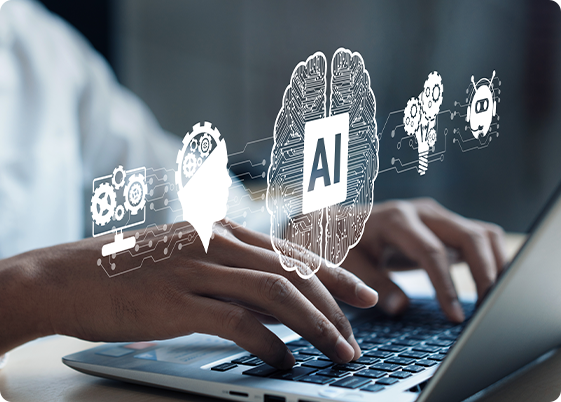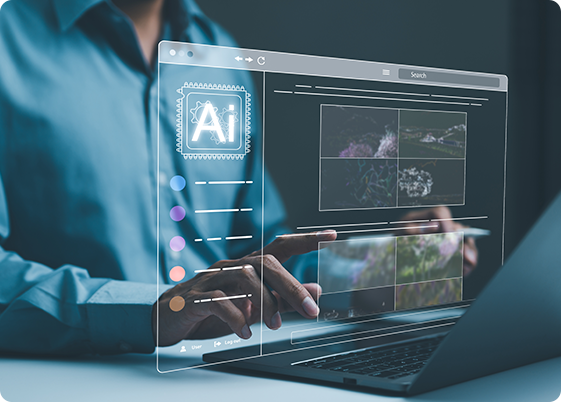In the digital age, businesses continually seek innovative solutions to maintain their competitive edge, enhance customer engagement, and streamline operations. One emerging technology that promises to revolutionize how companies approach customer experience (CX) and operational efficiency is generative AI. A well-defined generative AI strategy can empower businesses to create personalized content, automate workflows, and enhance decision-making processes.
This article explores how organizations can leverage generative AI to improve customer-facing and internal processes, offering practical insights and best practices and addressing potential challenges.

Understanding Generative AI
What is generative AI? Generative AI refers to a class of artificial intelligence models that can create new content based on existing data, from text and images to videos and even code. Unlike traditional AI, which analyzes data and provides insights, generative AI can generate novel outputs. These outputs can be in various forms, including conversational responses, realistic images, audio synthesis, or predictive models for decision-making.
The growing adoption of AI tools like GPT-4 and DALL·E highlights the transformative potential of generative AI. Companies across industries in the USA are exploring how a generative AI strategy can improve customer-facing processes and operational efficiency.
Improving Customer Experience with Generative AI
A primary area where businesses integrate generative AI strategy is customer experience (CX). By leveraging AI’s ability to produce dynamic content and personalized interactions, companies can deliver more engaging and tailored customer experiences.
Here are some places generative AI can help you with CX:

Personalized Content Creation
Customers today expect personalized content that addresses their specific needs and preferences. With generative AI, businesses can deliver this content at scale. For example, AI can generate product recommendations, personalized emails, or marketing materials based on customer data. This approach ensures that each customer receives information that resonates with them, boosting engagement and satisfaction.
A practical generative AI strategy framework for content personalization analyzes past interactions and purchasing behaviors, and then generates unique recommendations or messages tailored to the customer. It can be applied across industries, from e-commerce to financial services.
For example, an online retailer in the USA can use generative AI to create personalized shopping experiences by generating product suggestions based on a customer’s browsing history, previous purchases, or even trending products in their demographic.

Enhanced Customer Support
Customer support is another area where generative AI is proving invaluable. AI-powered chatbots and virtual assistants handle routine customer queries, provide real-time assistance, and even manage complaints. These systems can handle multiple customers simultaneously, ensuring quicker response times and improved customer satisfaction.
The best generative AI strategy will enhance these systems by enabling more natural language understanding and generating contextually appropriate responses. Instead of merely answering predefined queries, AI-driven bots can engage in more meaningful and dynamic conversations. It allows businesses to offer 24/7 support, ensuring customers receive assistance whenever needed without overburdening human agents.
Additionally, AI can assist human support agents by generating response templates or suggesting solutions, making the entire support process faster and more efficient.

Interactive Product Demos and Tutorials
Companies in the USA are also exploring using generative AI to create interactive product demos and tutorials. AI can generate simulations or tutorials based on the user's interaction, offering personalized guidance on using a product or service. For example, an AI-driven tool can create dynamic walkthroughs of software based on a user’s specific use case or offer a visual demo of a product tailored to customer preferences.
By integrating generative AI strategy into customer education efforts, businesses can enhance the product discovery process, making it more engaging and accessible.

Enhancing Operational Efficiency with Generative AI
While generative AI transforms the customer experience, it is equally powerful in driving operational efficiency. Businesses can streamline their operations, reduce costs, and enhance productivity by automating repetitive tasks, optimizing workflows, and improving decision-making processes.
Here’s how a generative AI strategy helps businesses improve their operational efficiency:
Automating Content Generation
Content creation can be time-consuming and resource-intensive for marketing, training, or internal communications. Generative AI automates this process by generating blog posts, product descriptions, training manuals, or internal memos with minimal human intervention. This capability allows businesses to scale their content production while maintaining high levels of quality and relevance.
For example, an organization regularly publishing content can use AI to generate the first draft of articles, product descriptions, or social media posts. The AI system can learn the company’s tone and style, ensuring consistency across different platforms and reducing the workload of marketing teams.

Optimizing Supply Chain Management
In supply chain management, a generative AI strategy can yield significant benefits. AI models can predict demand trends, optimize inventory levels, and even identify potential disruptions in the supply chain. By generating predictive models, AI helps companies make better-informed decisions regarding procurement, logistics, and inventory management.
For instance, AI can analyze historical data to predict when demand for a particular product might spike, allowing companies to adjust their production schedules accordingly. This reduces waste, improves resource allocation, and leads to more efficient operations.
Streamlining Internal Processes
Generative AI can also enhance internal workflows by automating repetitive administrative tasks. It includes automating report generation, employee onboarding processes, or scheduling meetings based on team availability. AI can generate detailed reports from raw data, allowing decision-makers to access relevant insights without spending hours manually compiling information.
Moreover, there is an increased demand for generative AI strategy jobs in the USA that can integrate these systems into business operations, highlighting the growing importance of generative AI in improving internal efficiency.

Challenges and Considerations in Implementing Generative AI
While the benefits of generative AI strategy are substantial, businesses must consider the following challenges and ethical considerations in implementing generative AI:
- One of the critical generative AI challenges is data privacy. AI models often require vast amounts of data to function effectively. It raises concerns about how customer data is collected, stored, and used. Businesses must ensure that they comply with data protection regulations such as GDPR or CCPA and that customer privacy is a top priority.
- Another challenge is the potential for bias in AI-generated content. AI models are trained on large datasets, which may contain biases. If not carefully monitored, these biases can manifest in the outputs generated by the AI, leading to unfair or inappropriate content. Companies must take steps to mitigate bias by regularly auditing their AI models and datasets.
- The cost and complexity of implementing generative AI are also significant considerations. Developing and maintaining AI systems requires a substantial investment in technology and talent. Companies must be prepared to invest in the necessary infrastructure, skills, and expertise to manage and optimize these systems.
- Finally, businesses must consider the impact of AI on their workforce. While AI can automate many tasks, there are concerns about job displacement. Companies must balance automation with human oversight, ensuring that AI is used to augment rather than replace human workers.

Best Practices for Developing a Generative AI Strategy
To successfully integrate generative AI into their operations, businesses should follow a set of best practices for generative AI strategy for both short-term success and long-term sustainability.
Here’s how to start:
Define Clear Objectives
The first step in developing a generative AI strategy is to define clear objectives. Businesses need to identify the specific goals they want to achieve, whether it's improving customer engagement, streamlining operations, or reducing costs. Without clear objectives, it can be challenging to measure the success of an AI implementation or justify the investment.
A generative AI strategy template can help organizations map their goals and the required steps. It includes identifying the key areas where AI can add value and the specific use cases that align with the company’s broader business strategy.
Invest in Quality Data
For generative AI strategy to work effectively, high-quality data is required. Businesses must invest in collecting, cleaning, and organizing data to ensure that AI models generate accurate and relevant outputs. Poor-quality data can lead to inaccurate predictions, biased content, and poor decision-making.
Companies should also ensure that their data collection practices comply with legal requirements and ethical standards in the USA. It not only protects customer privacy but also builds trust with stakeholders.
Start Small and Scale
Rather than attempting to overhaul entire operations at once, businesses should start by implementing AI in small, manageable projects. It allows organizations to test the technology, measure its impact, and make necessary adjustments before scaling it across the enterprise.
A generative AI guide can be a valuable resource for companies looking to implement AI gradually. Businesses can gain quick wins and build confidence in the technology by focusing on smaller, high-impact areas.
Monitor and Optimize
Once a generative AI strategy is in place, it is crucial to continuously monitor the performance of AI systems and optimize them over time. AI models are not static; they must be regularly updated and improved to remain effective. It involves tracking key performance indicators (KPIs), identifying areas for improvement, and making adjustments as needed.
Moreover, as AI systems evolve, businesses must be ready to invest in the necessary talent to manage and optimize these technologies. It includes hiring or training professionals with the skills required to maintain AI models, ensuring that the organization stays ahead of the curve in an increasingly AI-driven market.
Conclusion
In conclusion, a well-planned generative AI strategy can improve customer experience and operational efficiency, providing businesses with a competitive advantage in a rapidly evolving market. Generative AI can transform how companies interact with customers and manage their operations by personalizing content, enhancing customer support, and automating internal processes.
However, businesses must also be mindful of the challenges, from data privacy concerns to potential bias. Organizations can implement a generative AI strategy that drives long-term success by following the best practices—defining clear objectives, investing in quality data, starting small, and continuously monitoring and optimizing.
Are you a skilled IT professional looking to be at the forefront of AI innovation? HGS USA is actively offering IT jobs in the USA to seek talented individuals to join our growing team and help us develop and implement cutting-edge generative AI solutions. We offer a dynamic and rewarding work environment, with opportunities to collaborate with the top minds in AI.
 US
US Canada
Canada Colombia
Colombia India
India Jamaica
Jamaica Philippines
Philippines UK
UK SA
SA
